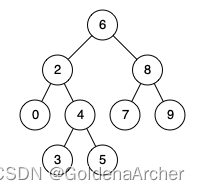[JavaScript 刷题] 树 - leetcode 235 & 236
235. 二叉搜索树的最近公共祖先
github repo 地址: https://github.com/GoldenaArcher/js_leetcode,Github 的目录 大概 会更新的更勤快一些。
题目地址:235. Lowest Common Ancestor of a Binary Search Tree
235 题目
如下:
Given a binary search tree (BST), find the lowest common ancestor (LCA) of two given nodes in the BST.
According to the definition of LCA on Wikipedia: “The lowest common ancestor is defined between two nodes
pandqas the lowest node inTthat has bothpandqas descendants (where we allow a node to be a descendant of itself).”
235 解题思路
这道题利用二叉搜索树的特性去解:
- 结点的左子树值小于该结点
- 结点的右子树值大于该结点
以案例中的图来说:

想要找到二叉搜索树的公共节点,只需要找到一个节点满足 p ≤ n o d e . v a l ≤ q p \leq node.val \leq q p≤node.val≤q 即可,换一个思路就是 $ node.val \nleqq p, q $ 以及 $ node.val \ngeqq p, q $ 即可。
再根据二叉搜索树的特性,如果当前结点小于 p , q p, q p,q,则在左数中搜索,反之则在右树中搜索。
使用 JavaScript 解 235
var lowestCommonAncestor = function (root, p, q) {
if (p.val > root.val && q.val > root.val)
return lowestCommonAncestor(root.right, p, q);
if (p.val < root.val && q.val < root.val)
return lowestCommonAncestor(root.left, p, q);
return root;
};
236. 二叉树的最近公共祖先
github repo 地址: https://github.com/GoldenaArcher/js_leetcode,Github 的目录 大概 会更新的更勤快一些。
题目地址:236. Lowest Common Ancestor of a Binary Tree
236 题目
如下:
Given a binary tree, find the lowest common ancestor (LCA) of two given nodes in the tree.
According to the definition of LCA on Wikipedia: “The lowest common ancestor is defined between two nodes
pandqas the lowest node inTthat has bothpandqas descendants (where we allow a node to be a descendant of itself).”
236 解题思路
题目已经给定了说结点一定存在于数种,因此只会存在两种情况:
-
某结点的左子树和右子树包含对应结点

-
某结点本身为对应结点

如果是情况 2 的话,那么直接就可以返回那个 node === p || node === q 这个结点了,因为题目中的两个先提条件:a node to be a descendant of itself 和 p and q will exist in the tree。前者表示一个结点的祖先节点可以是其本身,第二个条件则说明 p 和 q 一定会存在于树中。
使用 JavaScript 解 236
如果 left 和 right 同时存在于当前结点的左子树和右子树,则当前结点为 LCA,否则只要找到返回的结点即可。
var lowestCommonAncestor = function (root, p, q) {
// base case
if (!root) return null;
// 找到对应的结点则进行返回
if (root === p || root === q) return root;
const left = lowestCommonAncestor(root.left, p, q);
const right = lowestCommonAncestor(root.right, p, q);
return left && right ? root : left || right;
};